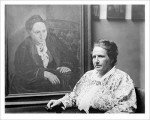Paul Alexander
On the cover of George Stanley’s You (Poems 1957-67) (New Star, 1974), there’s a detail of Paul Alexander’s painting “Twenty Questions.” The title of the painting comes from a popular parlour game and television show of the period that I watched as an adolescent in the 1950s. Participants could ask twenty yes or no questions to figure out the concealed identity of some person or thing. The first determination to be made was, “Is it animal, mineral or vegetable?”, as if the game were an ontological exercise in philosophy.
In Alexander’s painting, which is later reproduced in colour amid the text of the title poem, a large-headed figure sits on a chair or throne, one black-booted leg crossed over the other, while before him a red-headed man, enrobed in something resembling a clown’s outfit, is addressing the regal seated figure. The red-headed man appears to be a supplicant or Tiresias-like adviser of some sort; his hands are held before his torso, the fingers spread. The only other representational object in the picture is a white pyramid in the middle distance; the background is abstract, mostly peach-coloured.
In “You,” a poem about the Vietnam War whose point is that the rhetoric of war, the one in Vietnam or any other, is designed to erase our recognition of others as “you,” Stanley plays off Alexander’s iconic painting:
The Emperor sits across from me.
By his black boots I knew him.
Not right across from me–Look at the picture–he is to
my left (your right). He faces the West.
I crouch
somewhere in the hills
with a polychrome face,
diseased. I am a Poet. I can’t
sit like the Greeks do,
with their heels drawn up against their ass,
their elbows resting on their knees,
rocking on the floor. They counsel moderation in all things.
How little they know
of the Emperor. He is incapable of excess…
What’s compelling about Alexander’s mythic canvas and Stanley’s allusive invocation of its figures is the way art reflects the world to create another heretofore non-existent world. What begins as a mirror or representation of the world becomes an independent landscape, one whose figures and objects we can enter so that we, too, are doubled, multiplied, as either personnae or as an additional figure in the new landscape. At the same time, the painting and our “psychological” relationships to it are, literally, simply part of the world, but our conception of reality has become more complicated.
The curious, and otherwise inexplicable, emotional charge I get from the paintings of Paul Alexander and others is connected to an initiatory childhood experience. I’m unable to date it (age seven? twelve? it’s that vague), but I was taken to see the sumptuous painting collection of the Art Institute of Chicago–made possible, I now realize, by the railroad, grain, and livestock money of early twentieth century capitalism in the American Midwest.
From the beginning, looking at paintings caused a physical sensation in me, something akin to erotic excitation. The very idea that unshaped things–globs of colour, sticks of charcoal, the stuff I was familiar with from art classes in elementary school–could be used to make shapes, representations of people and landscapes that were both an interpretation of life and an entrance to a world larger than the one I knew, excited my wonder. Even earlier than my expedition to the Chicago Art Institute, around age six, I had been stirred by a reproduction of John Everett Millais’ “The Youth of Raleigh”–the first painting I ever “saw”–that hung in the waiting room of my Uncle Docky’s medical office. Two boys sit in the sand, along the seashore, at the feet of a veteran sailor, who sits on a log and points out to sea as he recounts an old salt’s tale, inciting them (and me) to adventure.
I immediately saw that the representations didn’t have to be exact, though some of them were, such as the harlequins and circus boys of Picasso–images that in one form or another, often just postcards, have been posted on bulletin boards within my daily sight for most of my life–but could also be “impressionistic,” “expressionist,” even “cubist” or “pointillist.” The Chicago collection possessed Georges Seurat’s “Le Grand Jatte” with its obsessive thousands of coloured dots.
Abstract painting was also comprehensible, though I eventually shared some of the Anglo-Irish painter Francis Bacon’s prejudice against it. Bacon thought abstraction could amount to no more than “decoration.” Still, figurative painting–Willem De Kooning, for example, whose work influenced both Paul Alexander and Tom Field–persisted in the period of abstraction’s dominance. Now, “painting” itself has almost been surpassed, by “installations,” “conceptual art,” and the like, although there are occasional returns of representation–Rainer Fetting’s “new figurative painting” of the 1980s, or those of my favourite contemporary artist, Attila Richard Lukacs. My friend Michael Morris periodically took me to Lukacs’ Berlin studio, a vaulted warehouse space located under the rumbling S-Bahn urban railway tracks not far from the Tiergarten park, to view Lukacs’ large and fantastical narrative canvases painted in the early 1990s. (Part of his “Young Spartans” painting, a homoerotic reworking of a canvas of Edgar Degas, is reproduced on the cover of one of my books, Then We Take Berlin.)
In our ceaseless visual scanning–right up to someone I saw on the bus yesterday afternoon–each of us for whom representation is indispensable maintains a personal catalogue raisonnee that not only shapes our understanding of everything we see, but whose each addition, and each subtraction (since we also forget), alters our vision of the whole. Somewhere in mine, then–and hence, this explication–are the images created by Paul Alexander.
Alexander was a tall, prematurely bald, soft-spoken man, the older brother of poet Jim Alexander. He was one of a number of so-called “literary” painters (Tom Field, Russell Fitzgerald and Fran Herndon were others) loosely attached to the North Beach poetry scene in San Francisco in the 1960s.
For many years, I was the owner of “Twenty Questions.” Eventually, at the urging of art curator Scott Watson, I gave it to the University of British Columbia art collection. But I still have various drawings by Alexander on the walls of my house–a sketch of a naked youth jumping (reminiscent of Muybridge’s motion study photographs), a watercolour of a book cabinet, an ink copy of the famous image of Europa on the back of a bull.
Alexander produced seemingly few canvasses. Besides “Twenty Questions,” I can only vividly recall a large painting which is a variation on Thomas Eakins’ renowned portrayal of young men swimming, and more dimly, a landscape of islands and sea, of one of the Gulf Islands off British Columbia, I think, that hangs in the house of Brian DeBeck, an old friend of mine. Once, I even sat for Alexander for a couple of days, but he judged the portrait a failure and it was abandoned. Another time, in Vancouver, he painted the kitchen in the house where I live, the doorframe trim in his exquisite shades of peach and mauve, leaving me with the experience of living inside one of his paintings. Though they are few, Alexander’s paintings expanded the dimensions of my reality, showing me stories and colours I hadn’t seen before. As in the game “Twenty Questions,” art reveals the identities of persons, places, and things, but even beyond that, art is juxtaposed to the world in such a way that our understanding of the latter is forever altered.
The poet Czeslaw Milosz, in his Milosz’s ABC’s, mentions the name of someone he knew long ago–Witold Hulewicz–and says, “For today’s readers just a name, nothing more, and this is somehow unjust.” Similarly, I feel disappointed that Paul Alexander has yet to receive the attention or recognition I thought he deserved.
It’s a sense I now have about many accomplished artists and thinkers I’ve known. While inordinate recognition (Andy Warhol’s “fifteen minutes of fame”) is bestowed upon a host of mediocrities, more deserving others and their works are “lost”; each year it’s less likely they’ll be recovered. But as a line in another of George Stanley’s poems cautions me, with justified vulgarity, “Is this a phenomenon anyone could observe or the twisted vision of a fucked-up old man”?
I could be wrong, or merely embittered. But I don’t think so. There’s a bit of popular pseudo-wisdom embodied in the familiar dictum, Who ever said life was gonna be fair? Even the tone of voice in which that colloquialism is (too easily) uttered implies a naivete on the part of the resistant idealist. But if at long last some of that oft-repeated cynic’s knowledge has seeped into my bones, that doesn’t mean I like it any better than I did the first time I heard it as a kid. The losses are permanent, the injustices irreparable. Not “mere” bitterness, but bitterness derived from a bitter taste.
The presence of the emotionally reserved, unassertive Alexander–even his conversation was somewhat bland–faded from my view with the decades. Alexander’s reclusive whereabouts were often unknown. Someone would vaguely report that he was living in poverty, working at a bit of gardening or domestic chores, in some small northern California town.
I imagine a retrospective of Paul Alexander’s collected works, all the paintings and drawings spread out through a series of spacious galleries, rescued from an unjust obscurity. But it’s unlikely this will happen while we’re alive. It’s merely a utopian fantasy of mine. So what good does it do?


